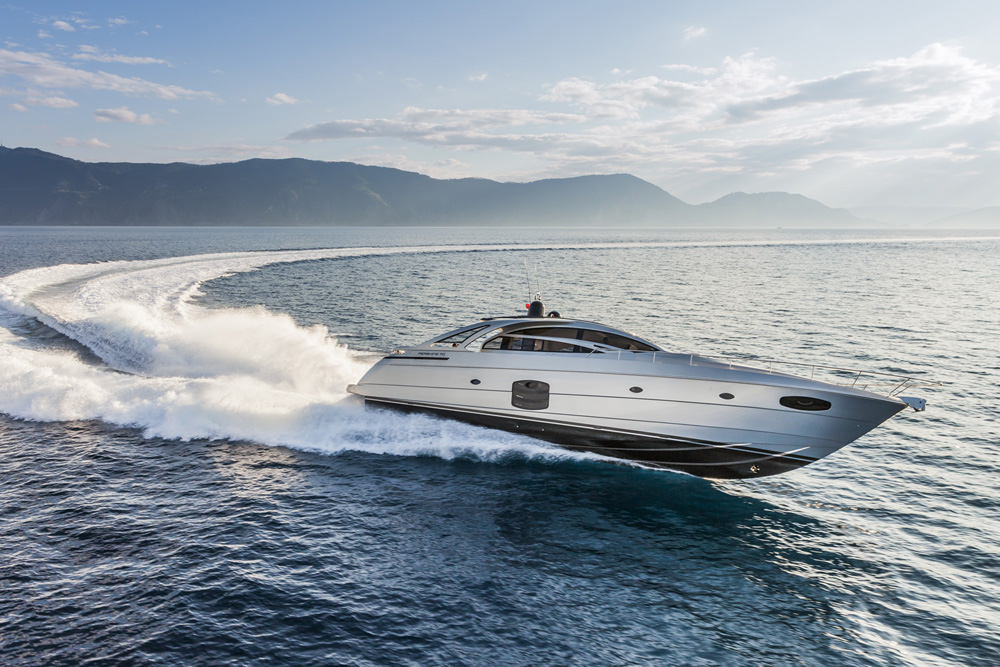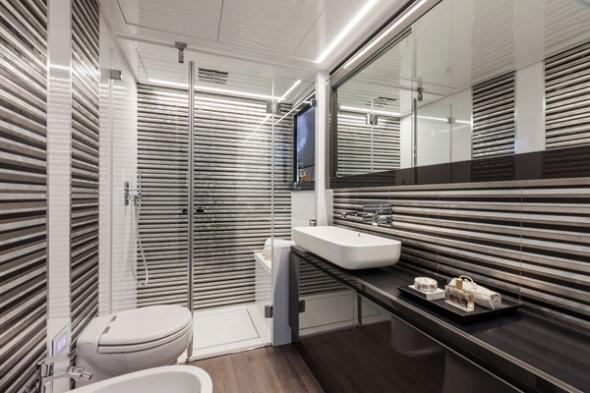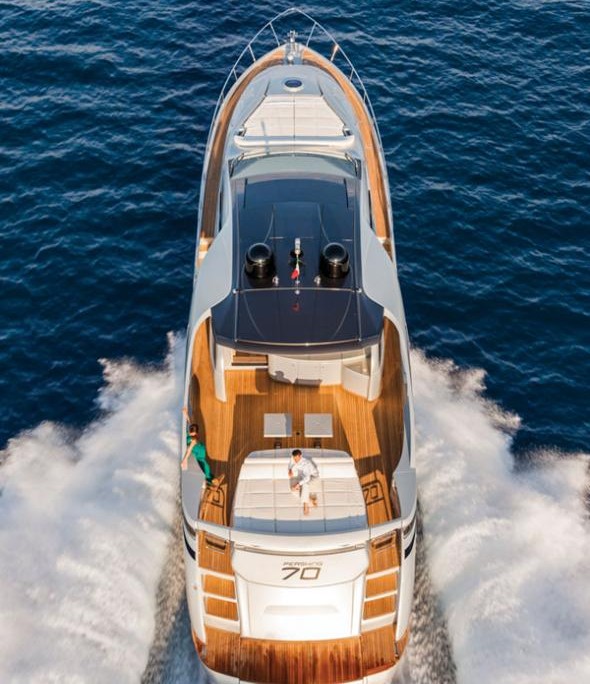The new technologically advanced Pershing 70 defines the real meaning of cool.
If one definition of cool is achieving great things without appearing to try too hard, then Pershing’s gleaming new 70 is very cool indeed. The Italian shipyard is famous for its hot-handling, high-performance, opulent motoryachts, but getting all those superlatives into one boat is no simple task—it’s as hard to make a stripped-down drag racer comfortable as it is to make a luxury cruising yacht fast.
But it doesn’t seem to be all that hard for Pershing—it’s just what they do. I was reminded of that fact, not for the first time, when having a look around the VIP cabin aboard this yacht at the Cannes boat show last fall. It was fitted with, I noticed, two sets of electric window blinds—one blackout, and one translucent. That’s right, two. So much for saving weight. Trying too hard? It wasn’t even breaking a sweat.
The Pershing 70 is a sleek, narrow-beamed, high-speed machine that throbs with latent power and turns on a dime. And yet at the same time it’s a supremely comfortable motoryacht, which would happily keep you and your family in the lap of luxury on a weeklong cruise. It’s a pleasure to be aboard both at anchor or in port, and it’s fun to drive—a lot of fun to drive.
Although sporting a slender, performance-oriented hull, the 70’s interior seems to retain the feel and space of a more substantial craft. Headroom down below is 6 feet 7 inches in the master and VIP, and higher elsewhere, while the berths are all full size or better. This sensation of space is heightened in the master thanks to those generous hull windows, and even more so up on the extravagantly glazed main deck, where there is also a substantial opening sunroof and a glass cockpit bulkhead that disappears downwards, further blurring the distinction between inside and out.
The décor was a familiar cocktail of restful shades, modern detailing, and contrasting tones and textures. Ash panelling, leather, lacquer, and stainless steel highlights, soft woolen carpets on the lower deck and intelligent use of reflective surfaces all work in harmony to keep the eye entertained. LED lighting lends a high-tech ambiance, but that’s not the half of it: the optional Videoworks one-touch system on the first 70 allows the owner and guests to control their environment via their iPhone or tablet, whether to choose a DVD to watch, or draw the curtains. It’s the future, apparently.
The layout of this three-cabin 70 felt roomy enough, but if you want more space the ultimate option would be the two-cabin version, with its private, open-plan saloon opposite the galley in place of the third cabin, and a roomy dayhead and shower at the foot of the companionway. The galley, though small, is bright and sociable thanks to its glass partition, and there are plenty of other instances of that stylistic flair for which Pershing is so celebrated. The external handrails on the superstructure sides, for example, which are so well disguised they look like part of the window framing, and the simple but effortlessly elegant tables in the saloon and cockpit, which precisely, and with pleasing geometry, unfold to double in size.
The real design award, though, goes to those distinctive “wings”—it’s hard to know what else to call them—which, for all their indulgent swoopiness, also have real practical value. They make the cockpit feel more secluded and protected, and they lend a sense of security when moving forward onto the side decks. Entirely unexpectedly, though, they also improve the aerodynamics at the stern, creating a clear flow of air over the transom and negating the vacuum-induced station-wagon effect that sucks exhaust gases and spray into the back of a boat when underway at speed. So at the end of our test, when I would normally expect to find a light coating of salt spray on the cockpit cushions, or at least on the transom, they were dry as a bone.
It’s always fun to drive a Pershing. Or it has always been fun for me: Every one I’ve had the pleasure of taking out has rewarded me with flawless handling, exhilarating performance and, of course, a pretty impressive turn of speed. With a deep-V, 23-degree deadrise amidships reducing to 17 degrees aft, the new 70 is based on the hull of the Pershing 64, which was 5 tons lighter and, with just 150 horsepower less, around two knots slower than the 70. The V-10 MTUs seem to be a perfect match for the new model, especially when linked up to the Italian-built Top System surface drives: we hit the advertised maximum of 46 knots right on the nose, with acceleration and handling everything they should be from a Pershing.
Getting the best out of surface drives takes practice, and when Pershing realized that a lot of yacht captains were unfamiliar with such high-performance machinery, the shipyard started to investigate automatic trim systems to help them match the speed and fuel-consumption figures achieved by Pershing’s own test crews. The latest manifestation of this quest is the Top System software fitted to the Pershing 70. The core principle is to keep the engines operating at a constant 80-percent load, lowering the drives into denser water when more thrust is needed and raising them as speed is optimized. This takes the guesswork out of accelerating from a standing start, and neither did we need any of the usual trial and error to discover that the 70’s minimum planing speed was 21.4 knots at 1550 rpm. In hard turns, the software lowers the outer drive and raises the inner one to equalize the water densities in which the props are operating, and it does so much faster than even a skilled helmsman could manage.
The Top System software is clearly the real deal, but for me it’s the superbly intuitive trim display, designed by Naviop, which seals it. In the mode of an old-fashioned aircraft turn-and-bank indicator, a circular dial in the center shows the elevation of the drives, the angle of the trim tabs, and the position of the helm. Around the perimeter of the screen are displayed engine rpm, boat speed, and the all-important engine-load percentages. When both engines are in the magic 80 percent zone, you get two green lights.
It’s a technological tour de force, and it achieves something I would never have thought possible—it makes driving a Pershing even more fun. Not only that, it enables every helmsman or helmswoman to drive the yacht to her full potential, without appearing to try too hard—which, as we all know, is the very definition of cool.
By Alan Harper




